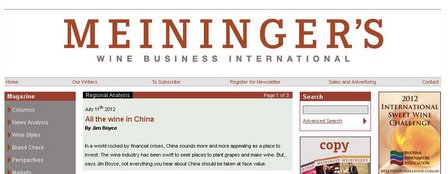(Posting this as a short break from helping with the Ningxia Wine Challenge. This region of China is paying for 10 foreign winemakers to visit this fall and make a red and a white wine. Details here. Deadline to apply is July 27.)
~
By Jim Boyce
Occasionally during my days in China, I remove the magnum of Lafite ’82 from my lips — save the environment, don’t use glasses — and put fingers to keyboard for the trade magazine Wine Business International. Editor Felicity Carter then shapes the material into something that looks written by a mature adult rather than an infant that took advantage of an unlocked liquor cabinet. Anyway, enough blabbering: the last piece I wrote for WBI focused on some China wine myths. The main thrust (my highlights):
International media reports about China’s wine industry make it sound as though local producers can bank on a limitless supply of cheap labour, hold an unfair advantage over imported wines that are subject to high duties, and jump into the global market as major export players, flooding the world with low cost wines, which will probably come from the Ningxia region.
Cheap labor: China is a huge country, with all kinds of population and skill densities. In Xinjiang, for example, the vines must be buried in the winter and uncovered in the spring. Winemaker Li Demei estimates that these tasks are responsible for one-third of the costs at a winery where he consults.
Add on the trend of young people moving from rural to urban areas, the vast distances workers need to be transported, and that other crops require picking at the same time as grapes — notably cotton and tomatoes — and it becomes obvious that labor costs are a huge issue.
High taxes: Almost every importer gripes that their wines face 48 percent in duties and taxes, while Chinese wines face nothing. Because of this, they also say it is unfair to compare rmb100 bottles of Chinese and, say, French wines. Is it?
Alberto Fernandez, who is managing partner of Torres China and handles both foreign and Chinese brands, says no: “While most imported bottled wines face just over 48% in duties and taxes, [Fernandez] says local wines… are subject to the same consumption and value-added taxes, which total about 30%.”
Chinese wineries also pay import duties on foreign barrels, road tolls to get their product to market, and other costs.
Export ambition: China has a strong export record and thus many people see it as logical that the country will soon flood the world market with wine. But floods require liquid and there is not a lot of that.
China has challenges making enough wine for its own market, let alone for export. Professor Ma Huiqin has estimated that in recent years some 30 percent of wine under Chinese labels has been imported bulk wine, although that number has been easing off.
Consider also that the world has a surplus of good wine, that most Chinese wines are far from that level of quality, and that local wineries find themselves with home advantage in the world’s hottest market, and it’s hard to see the incentive for focusing anywhere but here. The one reason to sell abroad is simply to market that fact to consumers at home.
In the article, I also looked at where the best place in China is to make wine — it depends largely on how you define “best”. Ningxia is a current favorite, Shandong has market access and skilled labor, and there is great potential in areas of Xinjiang and Gansu and along the Yunnan-Tibet border. There is lots more to be written on the “best” story.
Anyway, that is a summary of a much longer article in Wine Business International. You can find it here.
(Follow me on Weibo here, Twitter here and Facebook here.)
Grape Wall has no sponsors of advertisers: if you find the content and projects like World Marselan Day worthwhile, please help cover the costs via PayPal, WeChat or Alipay.
Sign up for the free Grape Wall newsletter here. Follow Grape Wall on LinkedIn, Instagram, Facebook and Twitter. And contact Grape Wall via grapewallofchina (at) gmail.com.


Leave a Reply
You must be logged in to post a comment.